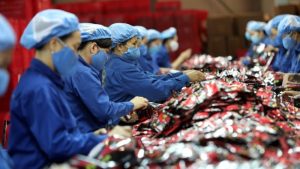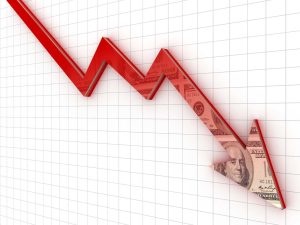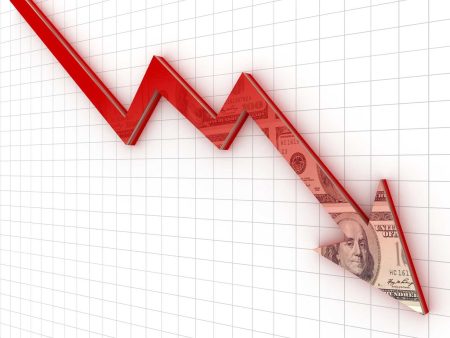The Goodyear Tire & Rubber Company (NASDAQ:GT) Q4 2023 Earnings Conference Call February 13, 2024 8:30 AM ET
Company Participants
Mark Stewart – President and Chief Executive Officer
Christina Zamarro – Executive Vice President and Chief Financial Officer
Conference Call Participants
Rod Lache – Wolfe Research
James Picariello – BNP Paribas
Emmanuel Rosner – Deutsche Bank
Operator
Good morning. My name is Nikki, and I will be your conference operator today. At this time, I would like to welcome everyone to Goodyear’s Fourth Quarter 2023 Earnings Call. All lines have been placed on mute to prevent any background noise. After some opening remarks, there will be a question-and-answer session. [Operator Instructions]
Today on the call we have Mark Stewart, Goodyear’s Chief Executive Officer and Christina Zamarro, Chief Financial Officer.
During this call, Goodyear will refer to forward-looking statements and non-GAAP financial measures. Forward-looking statements involve risks, assumptions and uncertainties that could cause actual results to differ materially from those forward-looking statements. For more information on the more significant factors that could affect future results, please refer to the important disclosures section of Goodyear’s Fourth Quarter 2023 Investor Letter and their filings with the SEC, which can be found on their website at investor.goodyear.com, where a replay of this call will also be available. A reconciliation of the non-GAAP financial measures that may be discussed on today’s call to the comparable GAAP measures is also included in the investor letter.
I will now turn the call over to Mark Stewart, CEO.
Mark Stewart
Thank you, Nikki. Good morning, everybody, and thank you for joining Christina and I this morning for what is my first conference call as the Goodyear CEO. I’m just now over two weeks in my new role. I could not be more excited to have joined this iconic company. As you guys can imagine, I’m working diligently, quickly to a deep understanding of our business. I’m meeting with our people, visiting our factories, getting to know our customers, our products, our cost structures, and doing that through operational deep dives.
I’m looking forward to engaging with the investment community as well over the course of the next several months to gain your perspective as well. As many of you have read, my most recent role was at Stellantis, where I ran the company’s North America operations and a key leader on the global executive team. I will bring a perspective from an automotive OEM and automotive supplier background and the understanding of needing to lead through industry cyclicality and a clear focus on manufacturing, purchasing, engineering and logistics in order for us to achieve our financials.
What this means is that in addition to spending time meeting our customers, understanding our products and product placement, you can expect me to focus heavily on Goodyear’s manufacturing operations and distribution, understanding it on every level, and working with the team to enhance capability and our cost effectiveness. As well, I will focus on clean sheeting and share cost activities, our SKU or product complexity, as well as our go-to-market strategies. Like all other aspects of our business, that focus will be centered purely around our Goodyear Forward in the coming months.
I’m engaged in deep dives on each element of the program, the associated work stream, our amazing teams, and committed to delivering the outcomes of the Forward plan. I’ve been a part of leading transformational efforts and driving results in my past roles and bringing them to the bottom line through clear KPIs, the definition, the tracking and speed of execution.
For Goodyear, for us, it’s about maximizing our strength and our market position in North America, is improving our cost structure as well as derisking our balance sheet. Ultimately, I’m confident Goodyear Forward will drive our company’s next stage of profitable growth and success. It’s clear, and I fully support the plan.
With that by now, you read our investor letter from yesterday evening. Christine and I would like to get right to your questions. So with that, Nikki, let’s open the line.
Question-and-Answer Session
Operator
[Operator Instructions]
We will take our first question from Rod Lache with Wolfe Research. Please go ahead.
Rod Lache
Good morning everybody. Good to talk to you again, Mark. I understand, Mark, that you’re just two weeks into working at Goodyear, but I wanted to give you a little bit more of an opportunity to talk about what you see as most important to create a durable industrial turnaround and what do you think the timeline will be for you to kind of put your stamp on the plan?
Mark Stewart
Yes. Thanks, Rod. I think what’s clear is going back again to the very well thought out Goodyear Forward plan, which was rolled out on November 15. Right? And that is my focus. It’s about streamlining the portfolio. It’s for us to get to sustainable operational margins of 10%, getting our net leverage to 2, 2.5x by end of ’25, and having that sustainable free cash flow that’s going to increase our overall financial flexibility.
So specifically, with a whopping two weeks in a day here, I’m right in the middle of this onboarding process. And again, I’m spending the majority of my time and plan to do so in the near-term listening to our team here at Goodyear, both at headquarters, in the plants, our retailers, our customers, meaning in retail, OE and distribution. And it really is looking forward to meeting you guys as well Rod in a different light from the past. Right? But I am deep diving into the operations, going through the functions, the financials to really thoroughly understand the business right now.
And so I’m asking lots of questions, taking lots of notes, continuously reviewing that, especially in this first 30, 60, 90 days to challenge what I think in coming in to gain the understanding from our team. Also to get clarification of things that maybe we can and I can put into some quick win categories and areas that the learnings that I have had from the past as well. So again, it really is about trying to keep that fresh eye look with a hard drive to execution, and it is about speed of execution. It’s about us delivering that Goodyear Forward plan.
A couple of the observations I’ve had in the first couple of weeks, again there’s incredible momentum in the Goodyear Forward plan meeting with the teams just as you look to the plans, well thought out, step-by-step timing, ownership, execution. And so that is what I’m here to do, is to help Christina and the rest of the team in terms of helping to lead and guide those initiatives across the finish line Rod.
Rod Lache
Great. Thanks for that. And just on the business, maybe, Christina, you can help us with this, cost performance is obviously starting to look a lot better now and I presume that that’s not really with much benefit from the Goodyear Forward plan yet. But the question just looking at the numbers, just continues to be market share. And I know that there are factors that affected it in every region, but even in isolation, just Goodyear’s year-over-year volume performance wasn’t great. So I’m hoping you can maybe just talk to us a little bit about, do you think that there’s market stability for Goodyear, or is that kind of a work in progress? In other words, do you think that even beyond Goodyear Forward, more realignment is going to be needed to the portfolio?
Christina Zamarro
Yes, sure, Rod. I’ll take it by region, and I’ll start with the U.S. and our fourth quarter replacement market share in the U.S. in 2022 was, I’d have to characterize it Rod as just abnormally high and it approached 28%. And that was all driven by your reference to the volatility and imports that we saw over the course of 2022, even at the tail end of 2021. When I look at our consumer replacement share in the U.S. in the fourth quarter of 2023, I’d say it’s in line with year-to-date results and reflects a more normalized level of sell in share. And even with the significant change on a year-over-year basis, looking at the volume decline, what I’d also point out to you is that our sellout share, so what’s getting bolted on to vehicles at retail, was in line with the industry. And so that gets to your question around a level of stabilization.
So we would expect a much more normalized market share going forward in the U.S., certainly with margins in excess of 10%, we are in a good market position in terms of share. That doesn’t mean that we won’t make changes to the portfolio around the periphery. We said that we will do that as part of Goodyear Forward through SKU consolidation, through our customer programs as we look to continue to grow our margins. But I don’t think there’s anything that significant there Rod. I do feel that we’ve stabilized in the U.S. compared to last year.
Having said all that, the Forward outlook for our mature markets say U.S. and Europe is both slow growth for 2024, something like up 1% to 2% feels tougher in the first half than in the second half. And we know we also have recent declines in raw material, so there’s that to put into the calculus as well. Now, when we think about EMEA, the past headwind has been our sales volume performance really going back to 2019. We’ve been hurt by our position in OE, and that’s where the industry has certainly fallen pretty dramatically off its peak. It’s also hurt in replacement, where we do tend to be more profitable.
As you know, I think going forward we see little downside risk to OE. Our OE forecast globally for 2024 is something that feels a lot more forward or a lot more level. But when I think about the consumer replacement market share in Europe, what I’d say is, we lost a lot of market share since 2019 to imported budget brands, and they have grown as a part of the industry about 15 million units since 2019 and that’s at the same time the industry shrunk 7 million units and so we’ve lost our fair share of that and that’s why we’re directing the restructuring dollars as part of Goodyear Forward to the factories in EMEA and that was all announced in the fourth quarter.
Rod Lache
So just, Christina, with that, once the restructuring is done in Europe, you would expect that business to be more defendable or more stable at that level?
Christina Zamarro
Yes. I mean, I would say we’re addressing the cost competitiveness with a couple of factories out. I think there will be more work for us to do beyond 2025. I think we can get Europe to a high single digit SOI margin performance. I don’t think we’ll get there by the end of 2025, but we’re beginning the work. We’re laying the groundwork. We’ve announced the two factory closures.
We’ve also announced a big SAG restructuring worth $100 million. And EMEA will also get their fair share of the purchasing and some of the corporate initiatives that we’re running as part of Goodyear Forward. So we do have a good path to earnings growth in the future in Europe, but I think it’s going to take a little bit longer than this two-year plan period that we’re talking about as part of Goodyear Forward.
Rod Lache
Got you. Okay, thank you.
Operator
Thank you. And our next question comes from James Picariello with BNP Paribas. Please go ahead.
James Picariello
Hi. Good morning everyone, and welcome aboard Mark. Just on the restructuring, the restructuring actions, the Goodyear Forward savings plan, so you’re calling for $350 million for the full year, $50 million in the first quarter. Just curious how we should be thinking about the remainder of the year in terms of the cadence? And then more broadly, as we think about divestitures and the need for the execution there to fund the heavy lift on the Goodyear Forward plan in 2025 to achieve that billion dollar plus exit rate, does all that need to take place this year for the timing to be maintained here in terms of the timeline? Thanks.
Christina Zamarro
Hi, James. So on the Goodyear Forward program, $350 million on a full year basis, $50 million in the first quarter, you can think about that as a big step up in Q2 and then a little bit of a leveling the rest of the year. But then what I would say is still ramping on through the fourth quarter as you can imagine, we’re building into a run rate through the end of 2025 with all of these programs.
When I look at the asset sales, I’d say the processes related to the sales of the three respective assets that we talked about on November 15 is underway and progressing as planned, so we’ll be back to you when we have significant developments. I’ll note that the outlook items within the investor letter don’t contemplate an asset sale, so we’ll have to come back to you and adjust our box once we close on any sale. But I would say for the 2024 plan, no requirement for additional funding this year from an asset sale in order to achieve our plan.
James Picariello
And maybe this is a question we could answer offline, but just for context, if no divestiture takes place this year, just for context, what would be the additional restructuring Goodyear Forward savings that would be in store for next year just on an incremental year-to-year?
Christina Zamarro
Yes. So when we laid out the plan in November, James, we had said $350 million in year one and $750 million in year two.
James Picariello
Right, but what about under the hypothetical that the divestitures don’t take place this year? Again, purely hypothetical, just what would be the incremental push to next year without that additional funding source for the additional actions? Does that make sense?
Christina Zamarro
So, as of today, we’ve announced restructurings of about $750 million as compared to that guidance of 1.1 that was in our November announcement. So we’ve said $300 million of that sits in 2024, $350 million sits in 2025, and that leaves the remaining stub in 2026.
James Picariello
Got it. I much appreciate it. And then if I could just ask one more, just on the full year, kind of a follow-up to Rod’s question, just on a full year basis, would you be surprised if Goodyear’s unit volumes were down for the full year where you’ve got the -2% for the first quarter, just wondering if we could kind of establish that barometer in terms of just expectations flat or up or down for the full year in terms of units? Thanks.
Christina Zamarro
Yes. I mean, maybe I’ll take the opportunity, James, to just talk through a year-over-year SOI view, and that will get you at least sort of how I’m thinking about volume, but I’ll go through all the drivers at once, if that makes sense. On a year-over-year basis if you start with our 2023 SOI of $968 million Goodyear Forward obviously adds that $350 million against rate inflation of $215 million.
Other costs, so these are costs in transportation and energy, on a full year basis should be about flat. I do see right now a tailwind of $75 million in the first half that’s driven by transportation rates, but will flip to headwinds in the back half of the year, driven by increased insurance premiums as well as some transitional manufacturing inefficiencies related to our announced footprint actions in EMEA.
Then separately, with Toubro [ph] now at full production, we should get a $50 million benefit in the second quarter on a year-over-year basis. And then raw materials we’ve said are $375 million in the first half, first quarter price mix down $130 million. And then we’ll lap that about $60 million drag that we’ve been carrying with us as part of the commercial truck decline since the second quarter of last year, we’ll lap that in Q2, so our price mix in Q2 should be better than Q1.
We’re also looking to build a couple million units of inventory in the Americas as the levels are lower than what we need for optimal service levels as a result of the tornado and are managing the business for cash last year, that should benefit second half unabsorbed by about $40 million. I know we’ve said working capital will be neither a source or a use for 2024, but we do have some Goodyear Forward work streams that will help us offset that, particularly around procurement.
When it comes down to, and this was your question, James, what it comes down to is what you want to assume on volume, price and mix for the rest of the year. I think if you look at Asia-Pacific, we have been seeing steady growth of mid-single to high-single digit in our consumer replacement business. If you wanted to model that Q2 through Q4, I think that would give you another $35 million or so on volume and unabsorbed. And then you get to the mature markets where you have to balance this slower volume growth environment, call it up 1% or so against the declining raw material environment and what you think that means for our price mix.
James Picariello
Super helpful. Thank you.
Operator
Thank you. [Operator Instructions] We will move next with Emmanuel Rosner with Deutsche Bank. Please go ahead.
Emmanuel Rosner
And congratulations, Mark.
Mark Stewart
Thank you.
Christina Zamarro
Good morning.
Emmanuel Rosner
Good morning. So Christina, I appreciate all the good color around the work. I frankly didn’t have a chance to put it all into my little calculator and so back in real-time. So just trying to understand maybe in terms of bottom line versus your view in November, I think when you presented the plan to all of us, I think your high level view at that point was, look, we’re exiting 2023 with a fourth quarter margin of 7%, which you clearly over delivered on.
So that’s, call it like at the time you said $1.4 billion, sort of like annualized SOI and then on top of that, we can have net cost savings of about $100 million. So, like the gross savings minus the inflation. And so you were sort of, I think, suggesting that like 1.5 [ph] is something that is potentially a reasonable target. What does this year look like now that you have all the other puts and takes in place versus what you were describing a few months back?
Christina Zamarro
Sure, Emmanuel. So tracking back to our November 15 announcement, you’re right. We said that the run rate of the business exiting the back half of the year felt like about $1.4 billion. If I look at it today and adjusting for first quarter seasonality, we do have a big step down in Q1 always, because we generally sell about 4 million units less in Q1 than we do in Q4. We also drag in some inefficiencies from the holiday shutdowns into Q1. But what I would say, on top of all that, we do have to absorb about $60 million in OER [ph] mines that aren’t in the run rate.
So on a run rate basis, I would start, knowing where we closed at the end of the fourth quarter, I would start our run rate at 13.50. And then we know that we have the positive of Goodyear Forward of 350, we have a negative inflation of 135. And then outside of inflation, I articulated on the year-over-year walk just a $75 million headwind in the second half, driven by higher insurance premiums. And then some of these manufacturing inefficiencies related to our recently announced factory shutdowns in EMEA.
So that’s new news. And then against all that, again, that $60 million in OER [ph] mines that we’re going to absorb, that’s weighted to the first half. It’s even more weighted to Q1. And then that leaves your assumptions on how you want to build volume on top of that Emmanuel. So hopefully that gives you some clarity around the run rate.
Emmanuel Rosner
Sorry, just to clarify, the changes versus the new news, I guess, versus the November framework, is a little bit of a lower run rate. Call it like 50 million as an exit rate, and then sort of like this, 75 million headwind in the second half, and then your assumption on price mix volume. Is that it, or did I leave something out?
Christina Zamarro
Well, yes, and I would say OTR [ph] mines, we knew back in November, and when I answered the question, Emmanuel, in November, we said we’d have to come back in February and lay out our guidance for the full year. And so OTR [ph] mines are certainly a piece of it. Insurance premiums are a headwind against the run rate. And then we have these transitional manufacturing costs as part of the recently announced closures in Europe.
Emmanuel Rosner
Okay, thank you. And then on the cash side, so the CapEx was guided to, I guess, quite a bit higher than it’s been recently, I think $1.2 billion to $1.3 billion. I don’t remember it being sort of like a piece of the plan. Can you maybe just elaborate on what this is sort of related to? And then, conversely, I think the restructuring cash in the initial plan was going to be $600 million outlay in 2024 and now it’s $300 million. What does this relate to? Are there incremental efficiency or timing of spend? And does that impact the timing of savings?
Christina Zamarro
Yes sure. So I’ll start on the CapEx question and our guidance implies a $200 million increase at the midpoint to support new programs. We’ve given a range here. What I would say is, if you assume a weaker environment over the course of 2024, we’ll find ourselves at the lower end of that range, and at the higher end is in a more constructive volume environment and that’s typically how we’ve managed our CapEx spends historically.
The step up is really driven by two different new programs in the Americas to drive mix up. One is the factory modernization, one is the factory expansion. And the modernization is going to convert about 9 million units from LVA to HVA, and that will be at its annualized run rate by the end of 2025. And then another. I mentioned an expansion that’s going to add, call $2.5 million dollars of HVA capacity for us in annualized run rate by the end of 2026, so getting the full year benefit of that in 2027.
The second question on restructuring, the guidance as part of the November 15 announcement was $1.1 billion. We didn’t phase it for you. What we’ve announced up until now is $750 million. And just based on the timing of the factory closures that we’ve outlined, $300 million of that falls in 2024, $350 million of that falls in 2025, and the remainder in 2026. So it does feel like timing Emmanuel versus maybe what you had written down to start.
Emmanuel Rosner
Okay. And you’re talking about the spending here, the cadence you just gave?
Christina Zamarro
I’m sorry, Emmanuel, I didn’t quite hear you.
Emmanuel Rosner
The $300 million, the $350 million and then the remainder, this is the timing of the spending?
Christina Zamarro
That’s the timing of the $750 million of announced restructuring.
Emmanuel Rosner
Understood. Thank you.
Christina Zamarro
Sure.
Operator
Thank you. And this will conclude our Q&A session as well as our conference call. Thank you all for your participation and you may disconnect at any time.
Read the full article here










